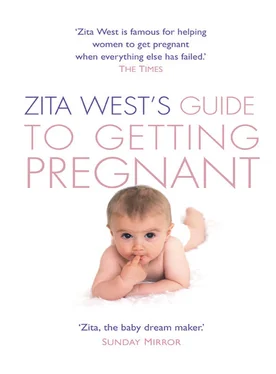If you are recording your temperature, there may be some cycles with no temperature rise (possibly indicating the absence of ovulation), while other cycles may show a rise in temperature but it may occur fewer than 10 days before the next period starts (indicating a short luteal phase). If this is the case, your cycle would not be fertile as there would be insufficient time for implantation to succeed.
Many women report heavier and brighter red bleeding after stopping the Pill – this can be quite alarming. Hormone – withdrawal bleeding which you get during the pill – free interval is much lighter and pinker than the fresh red bleeding of a normal period. If you are concerned, do talk to your doctor.
How will I know if I am ovulating or not?
It is not possible to tell from cervical secretions, temperature or LH kits whether ovulation is happening or not. The build – up to the wetter, clearer secretions indicates that ovulation is approaching, LH kits generally show that ovulation is imminent, and the rise in temperature may be a sign that ovulation has occurred – however none of these signs is conclusive.
Aim to have as much sex as possible at any time you see any cervical secretions – this gives sperm the best possible chance to start their journey!
It will be hard at first to recognize your individual pattern. If you are concerned about a delay in conceiving, of course you should speak to your doctor in the first instance.
For many women there is a wealth of minor signs and symptoms that can help identify their fertile times. Let’s take a look at some of these.
Increased Libido
An increase in libido – of course this is also related to other emotional, social and physical factors, but for many women trying to get pregnant, increased sexual interest is an indicator of hormonal changes around the time of ovulation.
Mid – cycle Abdominal Pain
Because the ovarian follicle enlarges, prior to ovulation, by up to 23mm, and ruptures at ovulation, it’s not surprising that some women become aware of a sharp twinge or dull ache on either the right- or left-hand side of their lower abdomen, about halfway between the navel and hip bone and halfway between the navel and pubic bone. This can last for anything up to a couple of hours, and may be combined with a crampy feeling, not dissimilar to menstrual cramps, which may be because of the swollen ovary or the extending of the womb and Fallopian tubes, caused by the increase in oestrogen. The actual cause of the pain is still not known – the most likely culprit, as identified by research carried out in Germany, is related to a very slight bleed into the peritoneum as the follicle ruptures.
With other fertility awareness already in place, many women can easily identify this time of peak fertility, which can be an extremely useful indicator. Mid – cycle, or ovulation pain is also referred to as mittelschmertz – though it has to be mentioned that research has shown that of all the subjective indicators of fertility, this one is the most varied in relation to ovulation (when studied on ultrasound scans).
Breast Tenderness
This is also an indicator, often unwelcome for many women, that they are about to ovulate. Tenderness leading up to ovulation tends to be tingling in nature, because of the oestrogen effect. Tenderness that comes on towards the end of the cycle, influenced by the progesterone effect, is usually characterized by a heavy and full feeling, rather than tingling.
Spotting
In a very few women it is normal for them to experience a little mid-cycle spotting, or to have pink – coloured cervical mucus because of this spotting. For those women this is an indicator of peak fertility, but because it is so uncommon is not often listed as a fertility indicator. In addition, any mid – cycle spotting or bleeding must be reported to your doctor and checked out, as it can be an indicator of infection or disease. Make sure you are up to date on your smear tests.
What if my LH surge does not relate to my secretions?
An LH kit shows that ovulation is about to happen (within the next 24 hours). Cervical secretions give you about 5 days’ warning. To optimize your chances of pregnancy, have sex from the time your secretions start (this is the start of the fertile time). Normally the LH kit will become positive after you have had fertile secretions for a few days. Do not wait for a positive result from a urine sample – by the time you get this you are nearing the end of your fertile time. If you do have a positive LH test, continue to have regular sex for at least two days afterwards.
What if all of the LH tests are negative?
This can be very alarming for women, as you only get five test sticks, and if you have no idea about your fertility you won’t even be sure of when to start testing. If a woman has an irregular cycle, ovulation could vary anywhere between days 14 and 28, or even earlier or later than this, making it very hard to pinpoint exactly.
The LH sticks may not work for some women, for example some women over 40 may have higher LH readings. Similarly, some women with PCOS may have raised LH levels. If you use the sticks and find that you do not see any negative days – i.e. all your test results are positive – this may be a sign that you have an abnormally high LH level throughout your cycle. This should be checked by your doctor.
Ovulation does not occur in every cycle. It can be affected by factors such as age, the amount of time since you last gave birth, whether you are breastfeeding, how long it has been since you stopped taking the Pills, your body weight and stress levels. It is quite common not to ovulate in around 1 out of every 10 cycles. If you have two or more consecutive cycles where you do not think you have ovulated, see your doctor.
Why is my doctor going to check my progesterone levels?
Your doctor may do a progesterone test to check for ovulation. This is commonly called a Day 21 progesterone test. Doctors aim to test for the hormone progesterone about halfway through the second half (luteal) phase of your cycle – and for a woman with a cycle of 28 days, halfway between day 14 and 28 is Day 21. However, this only gives an accurate reading if your cycles are 28 days long. For shorter cycles the test may need to be done earlier, for longer ones, later. To time this test more accurately – and if you are aware of your fertile secretions – aim to get the test done about a week after your peak secretion day (i.e. one week after the secretions change back from being clear, wet and stretchy to being thick, white or dry again). If you are taking your temperature regularly, aim to have your progesterone test about six to seven days after your temperature rose to its higher level.
If you are told that a progesterone test shows you are not ovulating, this is not necessarily all doom and gloom. It simply means that you did not ovulate during that particular cycle. The test may need to be repeated to get an idea of whether this was an isolated incidence or a common occurrence for you.
What does it mean if my secretions do not get to the raw egg white stage?
Some women never notice egg – white type secretions yet conceive quite normally. It is the quality of the secretions high up in the cervix that count for the sperm. Avoid feeling inside your cervix to check for secretions, as this can be quite drying. As we get older the amount and quality of secretions reduces – so you may have noticed that these secretions were more abundant in your younger years. A reduction in secretions could be related purely to your observations – or may be related to slightly lower oestrogen levels. Many women never see the really stretchy type of secretion – but feel wetter only.
Читать дальше












